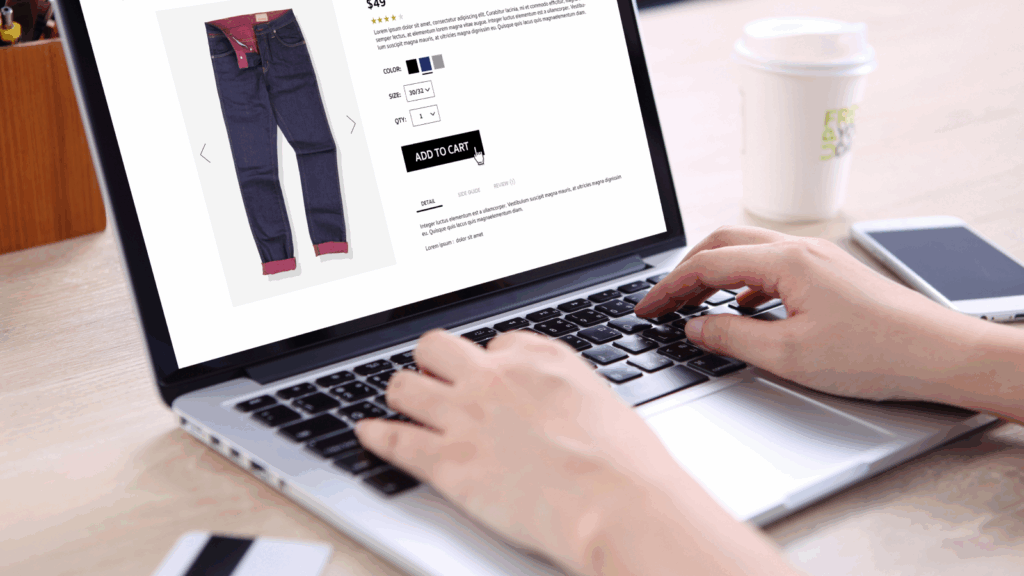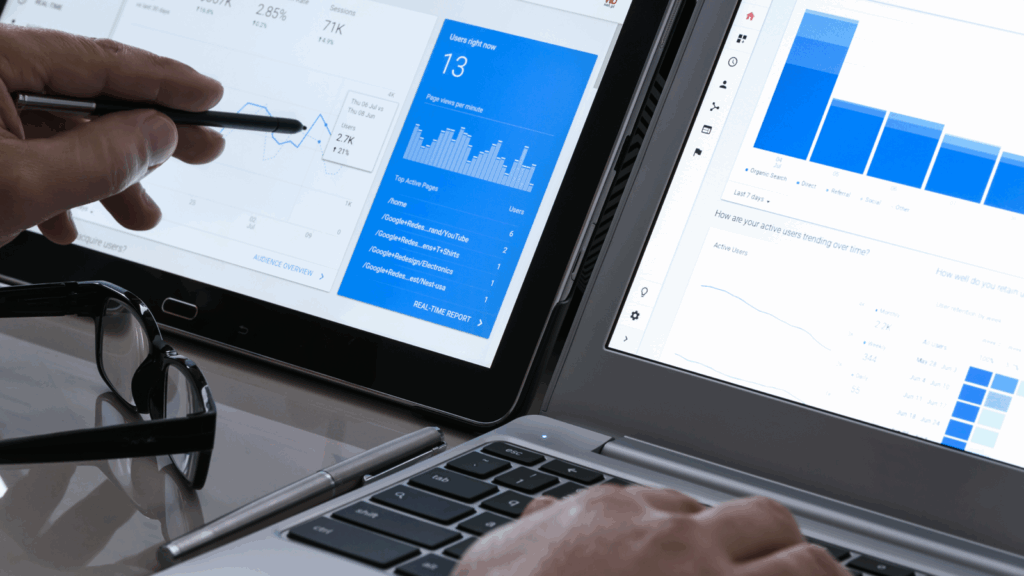Start your custom printing business today!
Wondering how to start a dropshipping business? With more people shopping online than ever before, now is an excellent time to get started.
Sell products online without inventory management and partner with a supplier who ships orders directly to your customers – no fuss, just profits.
In this article, we’ll cover how to start a successful dropshipping business from scratch, including everything from selecting a niche to marketing your store effectively.
This post may contain affiliate links, which means we may earn a commission if you make a purchase through those links. This comes at no additional cost to you.
Key takeaways
- Dropshipping is easy to start – you can launch a profitable business without holding inventory or dealing with shipping. Just find reliable suppliers and start selling.
- Picking the right niche with solid demand and low competition helps you stand out and attract customers.
- Marketing is crucial – use social media, SEO, paid ads, and influencer partnerships to drive traffic and improve sales.
- Print on Demand offers unique benefits for dropshipping. With Printify, you can sell custom products, enjoy higher profit margins, and scale quickly with low upfront costs.
- Continuously track your performance, refine your marketing strategies, and adjust to the market for better results.
What is dropshipping?

Unlike a traditional retail business, dropshipping is a popular sales model where you partner with multiple suppliers or manufacturers to sell their products in your own store.
When a customer places an order, you pass it on to your dropshipping partner. The supplier handles fulfillment, so you never have to worry about inventory management or shipping.
How do you make money with dropshipping?
Your profit margin is the difference between what customers pay you and the cost of the fulfillment process.
For example, if you sell a notebook for $10 and it costs $3 to make and $2 to ship, you keep $5. That’s a 50% profit margin.
A big advantage of running a dropshipping store is that you don’t need warehouse space, which means less financial risk and business expenses.
How to start a dropshipping business?

Wondering how to start dropshipping and turn it into a successful business? It’s simpler than you think. Here are some steps to help you kick things off.
1. Select a niche
For your new business to start generating sales from dropshipping, you’ll need to find a niche.
This is a specific market segment that caters to a targeted group of people with particular interests or needs.
Here’s how to identify and target a niche.
Consider your interests
Choose a dropshipping niche that aligns with what you like. This will make it easier to create compelling marketing content and connect with your target audience.
For example, if you adore cats and have a knack for creating funny captions, you could combine the two into a profitable cat t-shirt dropshipping business.
Research keywords
Conduct thorough keyword research on search terms related to your target market.
Use online tools like Semrush, Google Trends, and Google Keyword Planner to identify phrases with high search volume and low competition.
Evaluate market size and profit potential
Choose a niche with a growing customer base and offer unique products in markets with low competition.
Use dropshipping apps to research trending products and understand customer demand.
2. Analyze the market

Once you’ve chosen a niche, it’s time to do some in-depth market and product research. This will highlight potential opportunities and challenges, help you assess product demand, and perfect your sales strategy to better reach your business goals.
Review customer demographics
Understanding your target audience’s demographics will help you tailor your marketing strategies and product selection to better meet customer expectations.
Use tools like Google Trends, Google Analytics, social media insights, and market research reports to discover their ages, genders, and locations.
Engage in niche-specific forums, Reddit communities, and Facebook groups to gain firsthand insights into what your potential customers are discussing.
Review your competition
Identify competitors by analyzing relevant search terms on Google and best-selling items on marketplaces like Amazon.
Find the top-ranking dropshipping websites that also sell to your niche. Analyze what these eCommerce businesses are offering, their pricing strategies, and marketing efforts.
Read both positive and negative reviews to gain insights into what customers like and identify gaps in the market that you could fill.
Follow market trends

Stay updated on emerging trends to anticipate shifts in consumer behavior and adapt your sales strategy accordingly.
For example, if you’re in the fashion niche, monitor current styles and follow popular social media influencers to align your products with the latest in the industry.
Test the market
Run small-scale ad campaigns on platforms like Facebook or Google to test the market response. This provides valuable data on customer interest and potential sales volume.
Collect feedback through surveys or beta testing groups, and use this to refine your product selection and marketing strategy.
3. Select a dropshipping supplier

Your dropshipping supplier can make or break your business, so carefully review your options before entering a dropshipping agreement contract.
Since you’ll have limited control over product quality and shipping times and costs, it’s important to vet suppliers with a good reputation, competitive prices, and reliable customer service.
Order a few sample products and evaluate the quality and delivery times. This is especially important if you plan to sell personalized merch like custom clothing or consumer products.
Partner with a few dropshipping businesses to maintain a steady product supply and reduce risks associated with supplier errors.
Want to stand out? Try dropshipping with Printify. Instead of selling generic dropshipping items, offer stunning custom products showcasing your own designs with the help of Print on Demand.
Enjoy higher profit margins while still benefitting from automated fulfillment. Our global Print Providers will prepare, pack, and ship your customers’ orders worldwide.
4. Decide where to sell

Once you’ve selected your suppliers, look for a selling channel that best aligns with your objectives and target market. Here are the types of platforms to consider.
Online marketplaces
These are virtual spaces where multiple sellers offer their goods in one location, similar to a physical market.
Selling channels like Etsy, eBay, and Amazon give you access to a large existing audience of shoppers, but you’ll have less control over your shop’s layout and aesthetics.
eCommerce platforms
These sales channels let you create your own online store with full control over your site’s layout, product listings, payment gateways, and customer experience.
Setting up a store on platforms like Shopify or WooCommerce takes a bit more effort, and you’ll be in charge of attracting visitors.
Social commerce
Popular social channels like Facebook, Instagram, and TikTok Shop let you sell products directly to your followers through integrated shops, posts, and social media ads.
Like online marketplaces, these networks offer a large audience and help drive organic traffic to your product pages.
5. Sort out your finances

Now that we’ve covered the fun parts of how to get into dropshipping, let’s go through getting your finances in order.
Here’s a quick checklist to help you prepare to launch a dropshipping business.
1. Open a business bank account
Keep your business and personal finances separate to streamline your bookkeeping and simplify tax preparation. This also makes it easier to apply for a business credit card.
2. Set a budget
Although starting a dropshipping business with zero upfront investment is possible, knowing your available finances helps you allocate resources wisely, prevent overspending, and secure funds for growth and incidentals.
3. Create a pricing strategy
Calculate your costs, including product, marketing, platform, and shipping fees, and set prices that cover these expenses while keeping a healthy profit margin.
Review and adjust your pricing regularly based on market trends and customer demand. To attract more sales, offer discounts or promotions during holidays – check out our eCommerce calendar to plan ahead.
4. Plan for taxes
Understand your tax obligations, including US sales tax, VAT laws in the EU, and income tax. Some selling channels like Etsy collect and remit both sales tax and VAT on your behalf, but you may still need to file a tax return.
Set aside funds for tax payments and consult a tax specialist to make sure you comply with your country’s laws and regulations.
6. Get a business license
Getting a business license is important to run your dropshipping store as a legal entity.
Whether you’re setting up as a Sole Proprietorship or forming a Limited Liability Company (LLC), consult local authorities and legal professionals to understand the specific requirements in your area.
License, permit, and certification laws vary depending on your business structure and location.
7. Market your dropshipping business
Attract customers and grow sales by marketing your dropshipping business. Here are some key strategies to consider to help drive traffic to your store.
Build a social media presence

Social media is a fantastic tool for reaching your target audience. Platforms like Facebook, Instagram, and TikTok can help you showcase products and drive engagement.
Share high-quality images and videos, interact with your followers, and leverage platform-specific features like Instagram Stories and TikTok challenges.
Use email marketing
Create a mailing list and offer incentives like discounts or exclusive content in exchange for sign-ups.
Send regular newsletters with updates on new products, special promotions, and valuable content related to your niche. Personalize emails to make them more engaging and relevant to your audience.
Optimize for search engines
Search engine optimization (SEO) improves your visibility online, helping drive traffic to your website.
- Use relevant keywords in your content, product titles, descriptions, and metadata to improve your search engine rankings. This makes it easier for potential customers to find your products.
- Update your website regularly with fresh content, such as blog posts or product descriptions, to keep it relevant for both search engines and visitors.
Use advertising tools

Paid advertising tools like Google Ads, Facebook Ads, and Instagram Ads can help you reach a wider audience.
They let you target specific demographics, making it a smart way to drive traffic and increase sales. Experiment with different ad formats like video or carousel ads to see what gives the best results.
Influencer marketing
Find social media influencers in your niche to increase brand awareness. Collaborate through product reviews, giveaways, sponsored posts, and unboxing videos.
While influencers with millions of followers can provide broad exposure, micro-influencers (with 10,000 to 100,000 followers) often have higher engagement rates and more targeted audiences.
Utilize content marketing
Content marketing helps establish your brand as an authority in your niche and attracts organic traffic to your website.
Create valuable content that resonates. This can include blog posts, how-to guides, videos, and infographics that provide useful information related to your dropshipping products and niche.
Try affiliate marketing
There are two distinct ways to use affiliate marketing, and both offer powerful opportunities to grow your dropshipping business:
- Launch your own affiliate program – Invite bloggers, social media influencers, and industry experts to promote your products in exchange for a commission on the sales they generate.
- Join existing affiliate programs – Partner with other companies and promote their products on your website or social media to generate additional income while enhancing your brand’s credibility.
8. Monitor and optimize
It’s essential to monitor and fine-tune your operations regularly to keep your dropshipping business running smoothly and growing effectively.
Track store performance
Many selling channels offer built-in analytics tools. Use this sales data to monitor your store’s traffic, conversions, and customer feedback to stay ahead of other sellers.
Track financial performance

Regularly monitor your financial metrics like revenue, expenses, and profit margins. Track sales tax and VAT collected through your online store to maintain accurate reporting and compliance.
Use accounting software to keep accurate records and generate financial reports.
Refine your strategies
Adjust your marketing tactics and tweak product offerings based on data insights.
Use tools like Google Analytics and Facebook Ads to refine your targeting, try different ad formats, and analyze the performance of your campaigns.
Review which marketing channels and strategies drive the most traffic and conversions, and allocate your budget accordingly.
Why is it worth it to start a dropshipping business?
Global eCommerce sales are expected to grow by 7.8% in 2025, resulting in worldwide online transactions reaching $6.87 trillion.
The dropshipping method is an attractive option for launching an eCommerce business because it is a low-risk, low-cost way to capitalize on the market.
With no initial investment, no inventory costs, and no need to handle shipping logistics, all you need is an internet connection and a supplier to start dropshipping on your own online store.
How profitable is dropshipping?

Dropshipping is an increasingly popular way for store owners to run a profitable eCommerce business with minimal financial investment.
Low startup costs
Dropshipping eliminates the need for large upfront investments in inventory, warehousing, and shipping logistics – significantly reducing the financial risk of launching a new business.
Flexible profit margins
Source products at wholesale rates and set your own retail price to make a higher profit.
Keep in mind that you may need to set lower profit margins in highly saturated markets due to intense competition.
However, if you go with Print on Demand instead of traditional dropshipping, you can set higher prices on unique, custom products.
Multiple dropshipping suppliers
Dropshipping gives you the flexibility to work with various suppliers for a broader product selection – helping you easily adjust to market trends.
With Printify, you have access to overseas suppliers through a global network of Print Providers – all offering a wide range of high-quality products and fast shipping times.
Scalable growth
Dropshipping lets you expand your product offerings and reach new customers without the constraints of physical inventory.
It’s easy to sell new items, test product quality, and enter new markets without financial risk.
Get inspired by these examples of successful dropshipping stores.
Advantages of Print on Demand for dropshipping

Print on Demand (POD) offers some serious perks over traditional dropshipping, especially if you’re looking to build a strong brand or learn how to start dropshipping for free.
Here’s why POD stands out:
- No inventory hassle – Forget warehousing and bulk orders. You only pay for products when you sell them, keeping startup costs low.
- Lower shipping costs – Many POD suppliers offer affordable dropshipping services, delivering customer orders from the closest fulfillment location.
- Easy customization – Build a strong brand identity by designing unique products to stand out in a crowded market and gain customer loyalty.
- Scalable growth – Adding new products to your eCommerce website is quick and effortless. Test new ideas without financial risk.
- Higher profit margins – Custom items often have better profit potential than generic dropshipping products.
POD makes it easier than ever to launch and scale your business. Join Printify and get access to over 1,300 custom products, from apparel and tech accessories to home decor. Use our Product Creator to design merchandise and dropship within minutes.
Launch a POD dropshipping business with Printify today

Still wondering how to make money dropshipping? Sign up with Printify and start creating and selling custom print-on-demand products.
Dropshipping FAQ
The dropshipping model lets you sell finished products without holding any inventory or managing fulfillment and shipping.
Instead, when a customer orders from your online store, you forward the details to a third-party supplier, who then fulfills the order and ships it directly to your customer.
- Choose a profitable niche – Find something that aligns with your interests and market demand, whether that’s stylish tech accessories or trendy apparel.
- Do your research – Understand your target audience, check out competitors, and find a way to stand out, like with custom print-on-demand products.
- Set up the essentials – Find suppliers, choose your sales channels, and organize your finances and business licenses.
- Market your store – Use social media, email marketing, SEO, and paid ads to attract your target audience.
- Track performance metrics – This will help you refine your business strategy and improve your chances of success.
While it’s possible to start dropshipping for free with Print on Demand using Printify, the actual costs of running an eCommerce store can vary.
As a dropshipping business owner, you’ll need to account for eCommerce platform fees, marketing costs, product samples, and any payments related to your status as a legal business owner – including sales tax, VAT, and other regulatory fees.
That said, spending $50 to $100 might be all you need to launch a successful dropshipping store.
Yes, dropshipping is legal in many countries worldwide, including the United States.
To operate your dropshipping business legally, you must comply with local business regulations, tax laws, consumer protections, and product safety standards.
Ready to start dropshipping?
Dropshipping is a low-risk, high-reward business model and an excellent way to earn income from the comfort of your home.
Whether you’re a seasoned entrepreneur or just starting, Printify can help you build your dream online business.
With an easy-to-use Product Creator, seamless integrations with popular selling channels, and over 1,300 customizable products, you can stand out in a saturated market with Print on Demand.
Want to know how to start a dropshipping business with no money? Sign up today to create and sell custom products with Printify.




![Is dropshipping worth it in 2025 How to start a dropshipping business in 8 easy steps ([bp_year]) 1](https://printify.com/wp-content/uploads/2023/12/Is-dropshipping-worth-it-in-2025-300x199.jpg)









